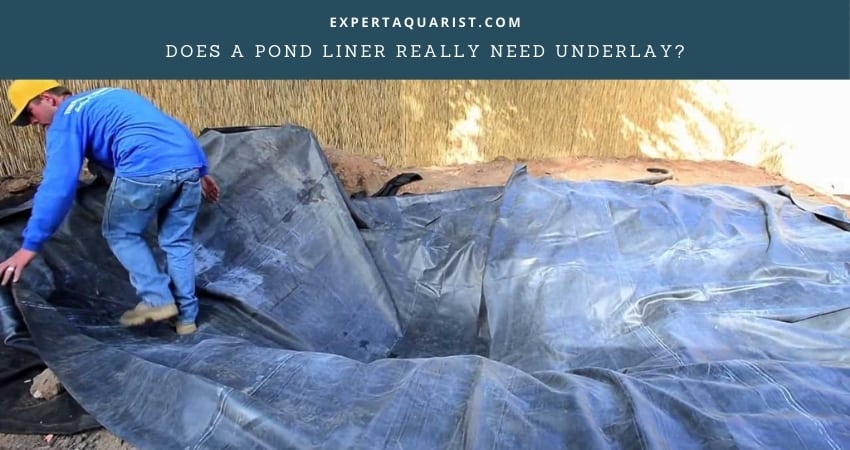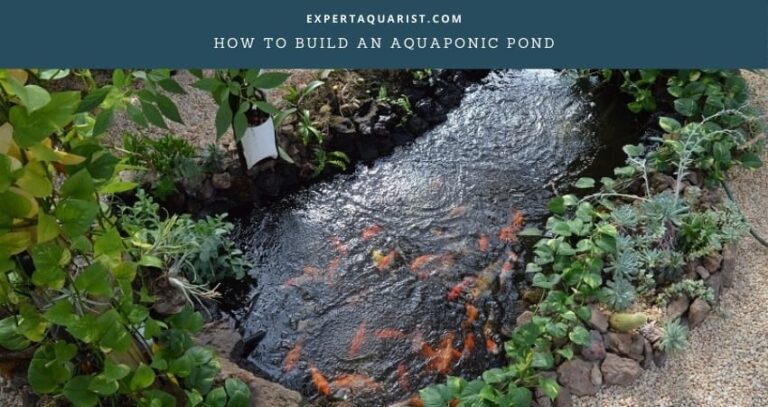When you are building a pond inside your private property you should make sure that the top to the bottom structure of the pond is powerful. With a low costing for the pond budget, your overall spending may become less but it can’t give you a rigid guarantee for a very long time.
However, in a properly planned pond, you should always install a pond underlay to make sure that the pond liner is safe from any kind of ripping or tearing from sharp objects which may lead to leaking of water in the ground.
Here, I will discuss the urgency and substantial need for a very good pond underlayer. I hope it might help you understand why does a pond liner really needs an underlay.
Why do you need Pond Liner Underlay?
Do you really need to install an underlayer beneath the pond liner? A big Yes for sure! As a pond owner, you should know that you are going to pour hundreds of gallons of water.
Do you have the answer to what will protect the pond liner from the sharp objects like rocks, roots, and debris under it?
Nothing is there to protect it because you do not have to install anything under the pond liner. As long as you are not installing an excellent pond underlay under the pond liner, it would be vulnerable to any kind of poking and tearing of sharp objects. If you want your pond liner to last for at least 25-30 years then you should install an underlay beneath the liner.
The benefits of using underlayer are many. As you get to know more about the details in the coming section you would realize it better.
If you are thinking that just by removing all the rocks and sharp objects you will be able to protect your pond liner then it would be a grave mistake. Although you will be able to wipe out a large number of rocks and other pokey things from the soil.

Despite that, you must take note that it won’t be possible for you to take out every particle on the soil that may pose damage to your pond liner.
Even if you can remove everything, as time will pass there might be some rocks and other objects like tree roots that may make their path to the bottom of the pond. Strong roots from high-growth plants like bamboo are known for pushing through the pond liner by puncturing it.
Unfortunately, if this happens then the pond liner will be damaged as a result of poking and piercing.
The underlayer is also important if you add gravel and stone to your pond. You can install an underlayer on top of your liner. It will help the liner from getting punctured from the gravels and stones which are part of beautification.
Another thing is that with time as the pond starts to settle into a shape that areas of the liner will be highly under stress for a long time. If you don’t have an underlayer, the chances of water leaking into the ground are very high.
So to stay in a peaceful mind just install a high-quality underlay and enjoy the serene view of your pond for a long time. Trust me it’s easy, safe. And definitely, it would be cent percent worthful.
Are you confused about which underlay one to buy?
Which pond liner underlays I am going to use? This question is swirling in your mind, Right? When you visit any online shop, you may just become confused about which underlayer to buy. Are you going to use carpets? Or Are you going to use the newspaper? You also might be thinking that “should I buy the underlayer which is made of mixed fabric?”.
Well, I will elaborate in the below part which underlayer is made of what and how strong they are for the protection of your pond liner. So, stay tuned.
Different Types of Pond Underlayer
In any pond forum, you will find that there are suggestions to install carpet, newspaper, and sands, etc as your pond underlayer. But you need to realize that some of them have some serious drawbacks. Below I will talk about the quality, longevity, and problems of different types of underlayers.
Carpet
Carpet is usually a dry thing when you buy it from the store and use it in your sitting room. So when you are going to use it as an underlayer then it will become exposed to water. As a result, it will start to rot very soon and this will drastically shorter the longevity of the underlayer. In addition to that, a rotten carpet will attract mold, bacteria which will lead to a very bad smell around the pond.
A synthetic made carpet may help you to deal with this issue, But still, most of the carpets are mixed of different materials so the risk of rotting still lies there. The main raw materials of carpets are usually wool, linen, Tencel, jute, bamboo, nylon, and premium outdoor polypropylene. So you can see a majority number of them are organic which are prone to react when they are exposed to water.
Another problem is an old carpet usually has staples and tack after the installation. After reading all this if you are still willing to install carpet then I would suggest you buy one which is mostly made of inorganic materials.
Newspaper
Applying layers of hard folded newspaper at the bottom of your newspaper might sound like a very less costly pond underlayer. Newspapers are mostly made of tree material so it’s a highly biodegradable product. The moment your stacks of newspaper are going to be in touch with water they will start rotting after 6-8 weeks. Don’t get caught just because to save some money.
You should try to avoid newspapers to choose from for your underlayment. But if you really want to use it because of the low cost then you should use it in conjunction along with a geotextile liner underlay.
Sand
Some people suggest that sand liner is good for the use of underlayer. Sand underlayer can be useful because it can fill up the gaps after removing the rocks and other sharp objects. It can also help drain purposes.
But there are some negative sides too. You can’t use it on the side of the pond. One of the major problems is that with time the rock will emerge as the weight of the pond water will create pressure. Sadly if that happens and you don’t have anything between the liner and the sand then your liner will be going to puncture. Which will ultimately destroy the whole setup of your beautiful pond.
If you are determined to use sand for the underlayer then you should apply it with the geotextile pond underlay.
The proper way of installing an Underlay
After deciding the size of your pond it’s of utmost importance to measure the exact size for the setup of liner and underlay. So whenever you are installing a pond in your backyard or front yard you should make sure that you are keeping the track of the dimension of the dug area. It would make the task of installing underlay and pond liner very easy for you.
The measurement of width, length, and depth of your pond should be in your notebook before you are going to install the underlay. After taking the measurement of your liner you should buy an underlay that is a bit larger than the liner. So that under the liner some extra portion of underlay hangs on each corner of the pond.
In three-step, you can install your pond underlayer. And these are the following:
Step 1: Lay down the underlay at the base of your pond
For that, you need to assure that there are no rocks and sharp objects at the bottom. If your plan is to install multiple underlays you don’t need to stitch them or joint them. Just place one on the top of another by overlapping the fabric so the bottom soil is not visible.
Step 2: Place the liner
Now tuck the underlay and the liner into any spaces at the bottom of your pond so that there remains no open space. If you do not do it perfectly and evenly then through open space you will see air creating bubbles after adding the water. Be cautious while doing this step.
Step 3: Finally Put some rocks
Now take some heavy rocks and put those on the border of your pond. It will secure the fixing of the liner and underlay properly. Have a little look over at every corner to make sure everything is full okay for the final setup. Now your pond is ready. So just water into it and enjoy the rest of the journey as a pond owner.
Underlay You Can Buy For Your Pond
In the different marketplace, you will find some good quality pond underlay. The price may vary from $13 up to $825. Per square foot cost of underlay will be around $.25-$6. They offer different sizes starting from 50 square feet up to 5400 square foot underlay.
Here are two top-notch underlays that have several catchy bells and whistles. Please have a look.
Geotextile Pond Line
Geotextile Pond Liner Underlay is known as a top-notch quality underlay for your liner. The price starts from $10. This underlay is made of a material known as nonwoven polypropylene which is puncture resistant. This is very flexible and user-friendly.
Moreover, it comes in black and white color. The weight of the Geotextile is around 250gm/m². The thickness of the underlay is 2-3 mm which is pretty good. This underlay kit resists settling of the pond, soil shifting, and decomposition and is best for the retention of water.
One of the best things about this underlay is that they offer high protection from intruders like rodents.
EPDM pond liner and underlay combo
EPDM pond liner and underlay combo are also good. In an online store, different sizes are available like 25ft. x 25 ft. up to 40ft. x 45 ft., and the price per square foot can be from $.60 up to $.70. These are highly durable and their service area can be versatile.
The built-in quality is so high that you can be worry-free from any kind of cracks, splits, or brittles. Harsh winter won’t have any impact on the underlay. Their weight is also very high which indicates the .45 ml thickness of the underlay. It would be a very good option for underlayment.
Parting Words
Any pond owner’s least thing would be fixing the whole pond from the bottom which literally means from the scratch. I won’t say that you really need underlays that is premium All you need to do is to get a decent underlay to execute your plan smartly.
A smart, logical, and practical decision would be much more beneficial for your pond. You can stay relaxed for the next 25-30 years in a chill mood without even thinking of what is going down at the bottom of your pond.






